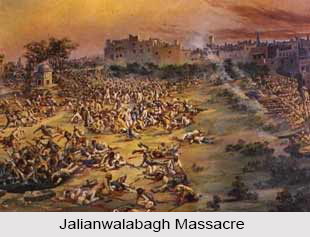 Jalianwalabagh massacre is one of the important chapters in Indian modern history, when India was under the shackles of British colonial era. It was firing to unarmed men by troops of the British Indian Army under the command of Colonel Reginald Dyer.
Jalianwalabagh massacre is one of the important chapters in Indian modern history, when India was under the shackles of British colonial era. It was firing to unarmed men by troops of the British Indian Army under the command of Colonel Reginald Dyer.
Beginning of the Bloody Event
In the year of 1919 the Rowlatt bill was introduced. Mahatma Gandhi immediately launched a Satyagraha campaign against them. He called for an all-India hartal on a specified day, requesting the people to suspend business and to resort to fasting and prayer. The hartal was a tremendous success. Throughout the early part of April 1919 there were demonstrations of all strikes across the country. As a rule they were not violent, but occasionally Satyagrahis got carried away by their enthusiasm and caused damage and also bloodshed. Gandhi was concerned that his campaign might be getting out of control. He admitted it had been a `Himalayan miscalculation`, and on 18 April 1918 he called it off and thus give it a wise decision.
Jallinwalla Bagh Incident
Meanwhile terrible things were happening in Punjab. But the country was completely unaware of this. The government censors were suppressing the monstrous news. The Punjabi people had given a spirited response to Gandhi`s call for non-violent protest. Successful hartals were held in Lahore (Pakistan), Amritsar, and other places as well. There were also occasional incidents of violence, to which the Punjab authorities responded with severe repression. Two local leaders, Dr Satyapal and Dr kitchlew were deported without trial. More disturbances followed and the military was called in. On 12th April Brigadier General Dyer issued a declaration prohibiting public meetings in the town of Amritsar District. He was an army commander. Many people did not hear of the declaration, and a meeting was arranged for the next day in an enclosed plot of ground called Jallianwalla Bagh. Dyer proceeded there at the appointed time. He found the Bagh filled with thousands of men, women and children. Many of whom had come to town to attend a festival, and had no interest in the peaceful meeting that was going on. Dyer stationed his troops at the place`s single entrance and, without warning the unarmed crowd, ordered his troops to open fire. For ten nightmarish minutes the sound of rifles drowned out the screams of the desperate people trapped inside the Bagh. One thousand six hundred and fifty rounds were fired with terrible accuracy. No less than 400 persons were killed, 1200 wounded were left lying in the dust when dyer went off to continue his oppressions elsewhere. It was the dust when Dyer went off to continue his oppressions elsewhere. It was not his job to look after them. He later said that they might go to the hospital if they liked. Amritsar men were flogged in public. They made to crawl with belly to the ground down a street where an Englishwoman had been attacked. Scores were tried by martial law commissions and sentenced to death transportation or imprisonment. Elsewhere, machine guns and even aerial bombs were used indiscriminately on the civilian population.
Dyer proceeded there at the appointed time. He found the Bagh filled with thousands of men, women and children. Many of whom had come to town to attend a festival, and had no interest in the peaceful meeting that was going on. Dyer stationed his troops at the place`s single entrance and, without warning the unarmed crowd, ordered his troops to open fire. For ten nightmarish minutes the sound of rifles drowned out the screams of the desperate people trapped inside the Bagh. One thousand six hundred and fifty rounds were fired with terrible accuracy. No less than 400 persons were killed, 1200 wounded were left lying in the dust when dyer went off to continue his oppressions elsewhere. It was the dust when Dyer went off to continue his oppressions elsewhere. It was not his job to look after them. He later said that they might go to the hospital if they liked. Amritsar men were flogged in public. They made to crawl with belly to the ground down a street where an Englishwoman had been attacked. Scores were tried by martial law commissions and sentenced to death transportation or imprisonment. Elsewhere, machine guns and even aerial bombs were used indiscriminately on the civilian population.
Aftermath of Jallinwalla Bagh Incident
When this reign of terror finally was over, the Indian people appealed for justice in vain. General Dyer was eventually removed from active service. But he was hailed as a hero by some Europeans. This was adding gross insult to injury. The Secretary State for War Winston Churchill and former Prime Minister H. H. Asquith openly condemned the attack. Sir Winston Churchill, on 8th July 1920, urged the House of Commons to punish Colonel Dyer. Churchill succeeded in persuading the House to forcibly retire Colonel Dyer, but Churchill would have preferred to see the colonel disciplined. Noble Laureate Rabindranath Tagore renounced the knighthood conferred on him by the king. Mahatma Gandhi declared that `Cooperation in any shape or form with this satanic government is sinful`. Netaji Subhas Chandra Bose left the ICS and joined with Indian National Congress under the guidance of Chittaranjan Das and MK Gandhi.



















